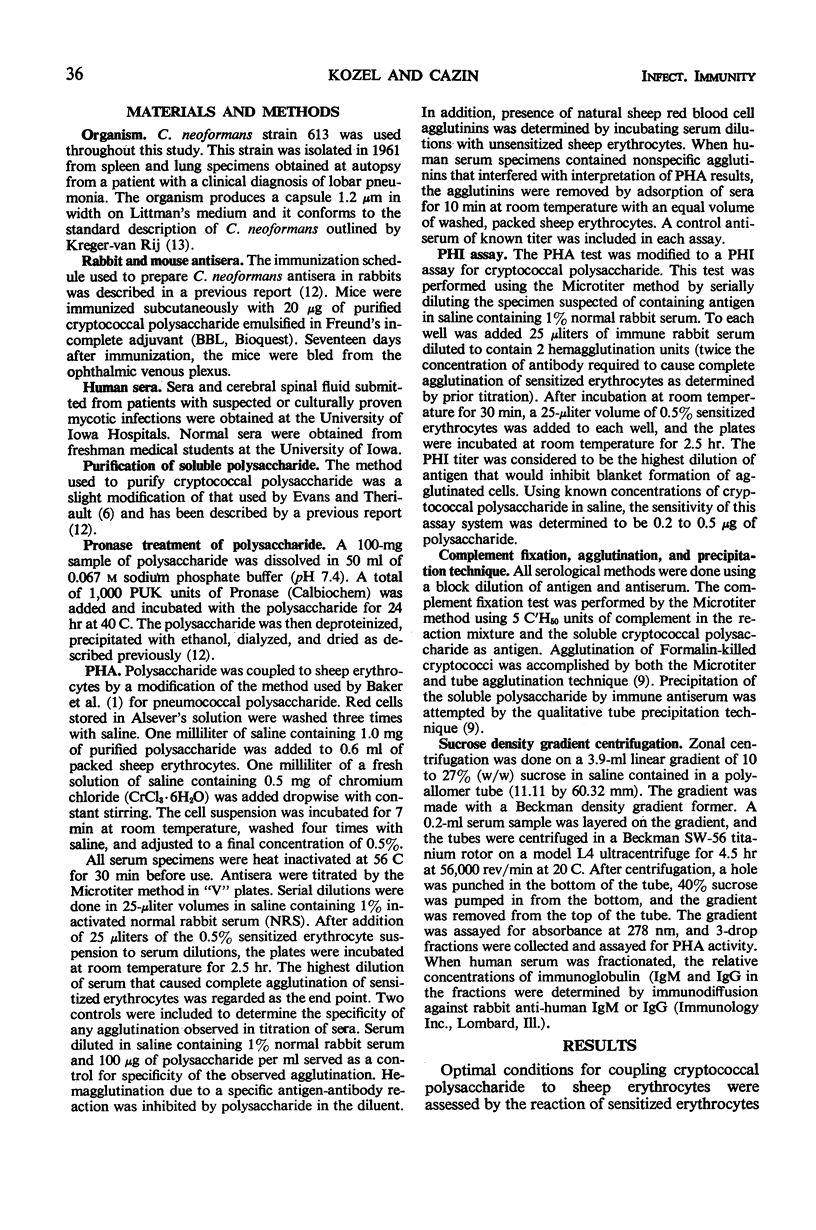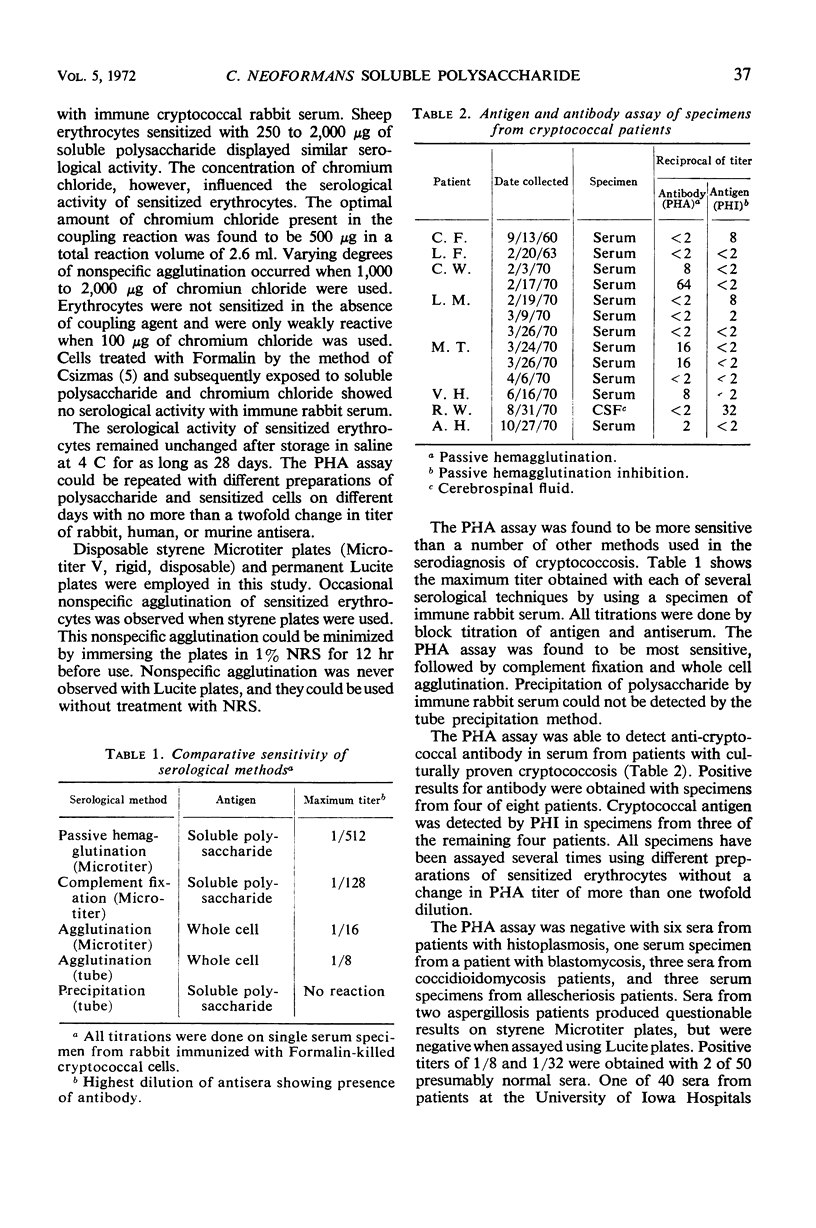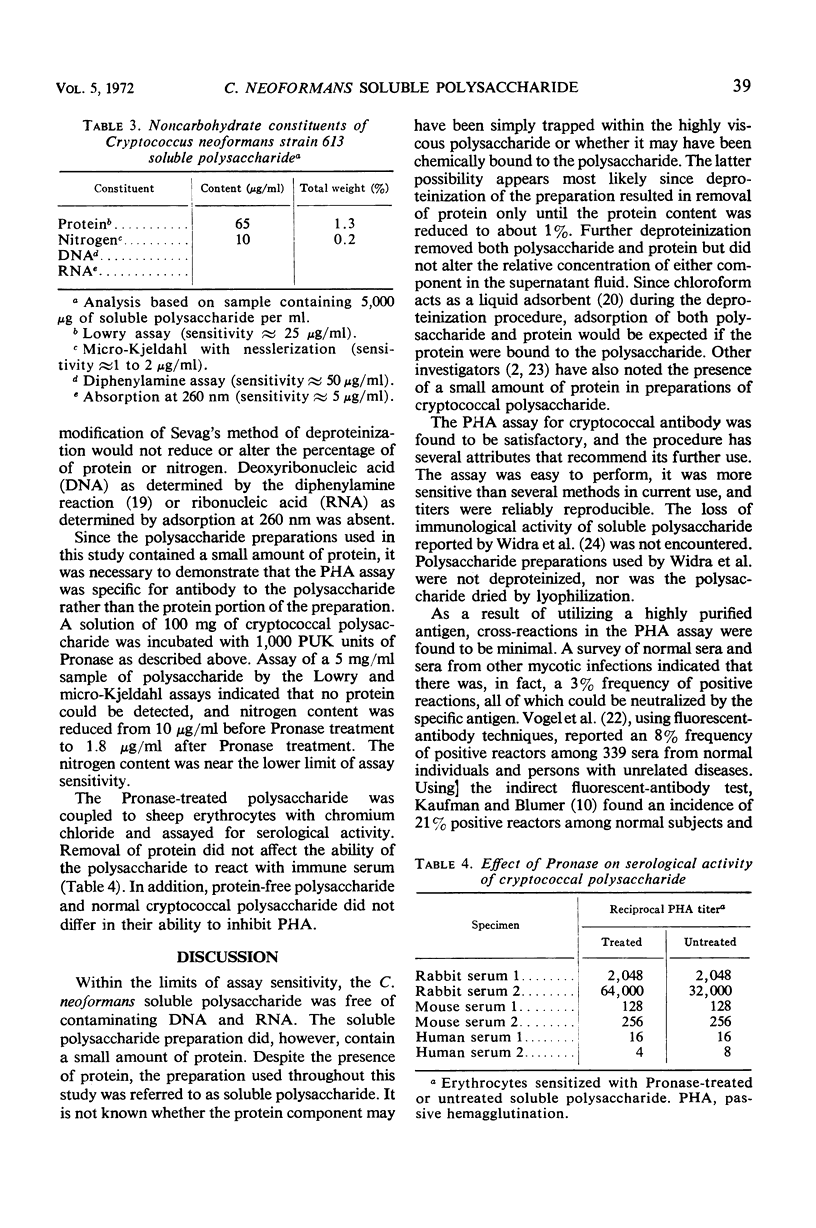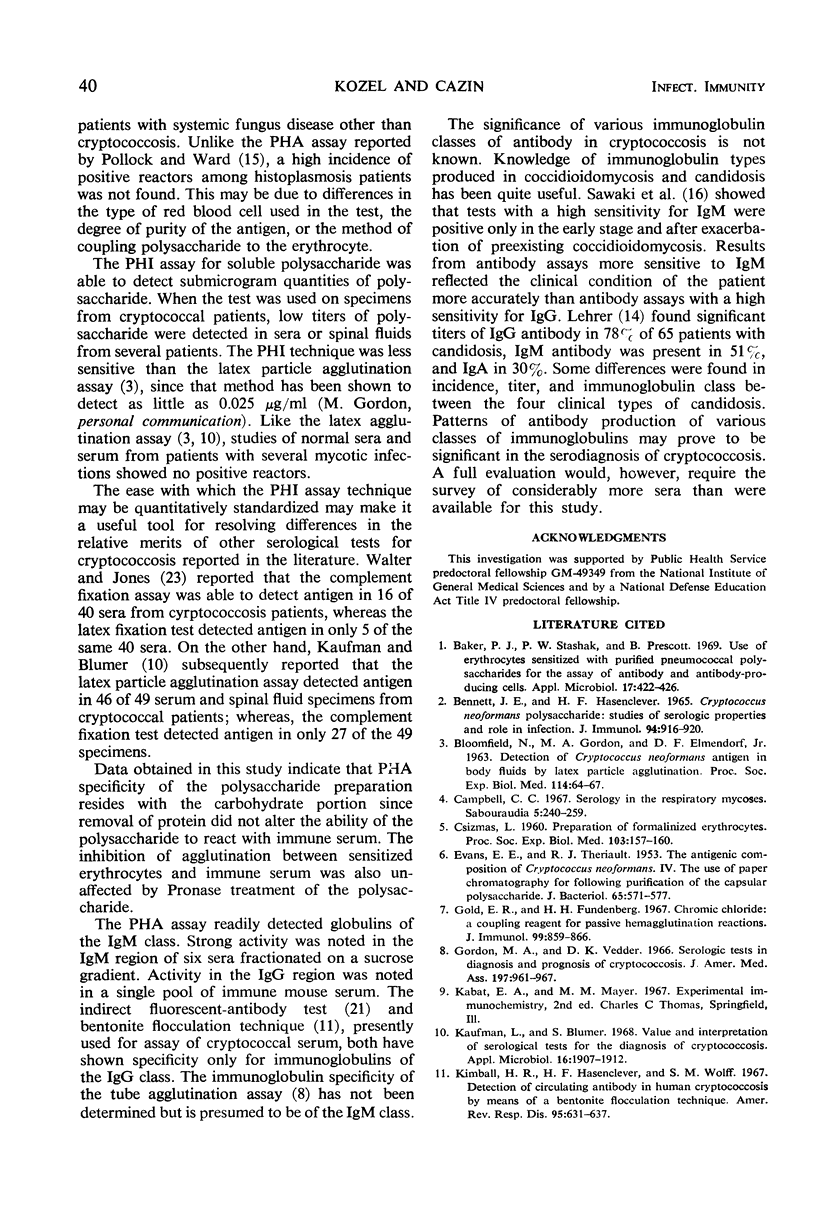Abstract
Chromium chloride was used as a coupling agent for the conjugation of purified cryptococcal polysaccharide to sheep erythrocytes. Sensitized erythrocytes were used in a passive hemagglutination (PHA) assay for antibody to cryptococcal polysaccharide and a passive hemagglutination inhibition (PHI) assay for antigen. The PHA assay was more sensitive than complement fixation, agglutination, or precipitation tests for antibody. The PHI assay could detect submicrogram quantities of soluble polysaccharide. Antigen or antibody could be detected in serum or spinal fluid from seven of eight patients with cryptococcosis. Tests for antigen or antibody were negative with sera from patients with histoplasmosis, blastomycosis, coccidioidomycosis, aspergillosis, or allescheriosis. A low frequency (3%) of positive reactors for antibody was found among sera from normal persons and from persons with unrelated diseases; whereas, all tests for antigen were negative. The assay showed a high degree of sensitivity for immunoglobulins of the immunoglobulin M class; however, cryptococcal antibody of the immunoglobulin G class was also detected. The immunological specificity of the polysaccharide preparation was due to carbohydrate rather than to protein associated with the polysaccharide.
Full text
PDF






Selected References
These references are in PubMed. This may not be the complete list of references from this article.
- BENNETT J. E., HASENCLEVER H. F. CRYPTOCOCCUS NEOFORMANS POLYSACCHARIDE: STUDIES OF SEROLOGIC PROPERTIES AND ROLE IN INFECTION. J Immunol. 1965 Jun;94:916–920. [PubMed] [Google Scholar]
- BLOOMFIELD N., GORDON M. A., ELMENDORF D. F., Jr DETECTION OF CRYPTOCOCCUS NEOFORMANS ANTIGEN IN BODY FLUIDS BY LATEX PARTICLE AGGLUTINATION. Proc Soc Exp Biol Med. 1963 Oct;114:64–67. doi: 10.3181/00379727-114-28586. [DOI] [PubMed] [Google Scholar]
- Baker P. J., Stashak P. W., Prescott B. Use of erythrocytes sensitized with purified pneumococcal polysaccharides for the assay of antibody and antibody-producing cells. Appl Microbiol. 1969 Mar;17(3):422–426. doi: 10.1128/am.17.3.422-426.1969. [DOI] [PMC free article] [PubMed] [Google Scholar]
- CSIZMAS L. Preparation of formalinized erythrocytes. Proc Soc Exp Biol Med. 1960 Jan;103:157–160. doi: 10.3181/00379727-103-25444. [DOI] [PubMed] [Google Scholar]
- EVANS E. E., THERIAULT R. J. The antigenic compostion of Cryptococcus neoformans. IV. The use of paper chromatography for following purification of the capsular polysaccharide. J Bacteriol. 1953 May;65(5):571–577. doi: 10.1128/jb.65.5.571-577.1953. [DOI] [PMC free article] [PubMed] [Google Scholar]
- Gold E. R., Fudenberg H. H. Chromic chloride: a coupling reagent for passive hemagglutination reactions. J Immunol. 1967 Nov;99(5):859–866. [PubMed] [Google Scholar]
- Gordon M. A., Vedder D. K. Serologic tests in diagnosis and prognosis of cryptococcosis. JAMA. 1966 Sep 19;197(12):961–967. [PubMed] [Google Scholar]
- KREGER-VAN RIJ N. J. Taxonomy of Cryptococcus neoformans and its variety uniguttulatus. Antonie Van Leeuwenhoek. 1961;27:59–64. doi: 10.1007/BF02538423. [DOI] [PubMed] [Google Scholar]
- Kaufman L., Blumer S. Value and interpretation of serological tests for the diagnosis of cryptococcosis. Appl Microbiol. 1968 Dec;16(12):1907–1912. doi: 10.1128/am.16.12.1907-1912.1968. [DOI] [PMC free article] [PubMed] [Google Scholar]
- Kimball H. R., Hasenclever H. F., Wolff S. M. Detection of circulating antibody in human cryptococcosis by means of a bentonite flocculation technique. Am Rev Respir Dis. 1967 Apr;95(4):631–637. doi: 10.1164/arrd.1967.95.4.631. [DOI] [PubMed] [Google Scholar]
- Kozel T. R., Cazin J. Nonencapsulated Variant of Cryptococcus neoformans I. Virulence Studies and Characterization of Soluble Polysaccharide. Infect Immun. 1971 Feb;3(2):287–294. doi: 10.1128/iai.3.2.287-294.1971. [DOI] [PMC free article] [PubMed] [Google Scholar]
- Lehner T. Serum fluorescent antibody and immunoglobulin estimations in candidosis. J Med Microbiol. 1970 Aug;3(3):475–481. doi: 10.1099/00222615-3-3-475. [DOI] [PubMed] [Google Scholar]
- POLLOCK A. Q., WARD L. M. A hemagglutination test for cryptococcosis. Am J Med. 1962 Jan;32:6–16. doi: 10.1016/0002-9343(62)90177-8. [DOI] [PubMed] [Google Scholar]
- Sawaki Y., Huppert M., Bailey J. W., Yagi Y. Patterns of human antibody reactions in coccidioidomycosis. J Bacteriol. 1966 Jan;91(1):422–427. doi: 10.1128/jb.91.1.422-427.1966. [DOI] [PMC free article] [PubMed] [Google Scholar]
- VOGEL R. A., SELLERS T. F., Jr, WOODWARD P. Fluorescent antibody techniques applied to the study of human cryptococcosis. JAMA. 1961 Dec 2;178:921–923. doi: 10.1001/jama.1961.73040480010008d. [DOI] [PubMed] [Google Scholar]
- Vogel R. A. The indirect fluorescent antibody test for the detection of antibody in human cryptococcal disease. J Infect Dis. 1966 Dec;116(5):573–580. doi: 10.1093/infdis/116.5.573. [DOI] [PubMed] [Google Scholar]
- Walter J. E., Jones R. D. Serodiagnosis of clinical cryptococcosis. Am Rev Respir Dis. 1968 Feb;97(2):275–282. doi: 10.1164/arrd.1968.97.2.275. [DOI] [PubMed] [Google Scholar]
- Widra A., McMillen S., Rhodes H. J. Problems in serodiagnosis of cryptococcosis. Mycopathol Mycol Appl. 1968 Dec 31;36(3):353–358. doi: 10.1007/BF02050382. [DOI] [PubMed] [Google Scholar]


